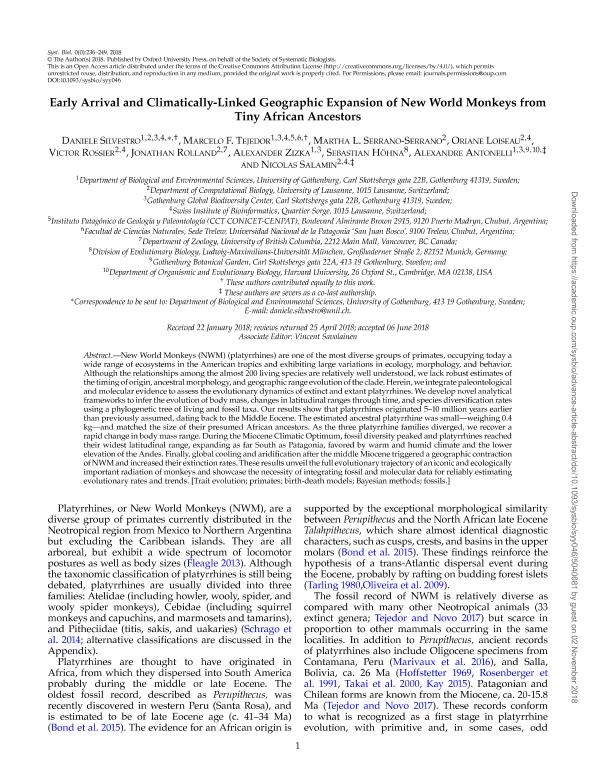Mostrar el registro sencillo del ítem
dc.contributor.author
Silvestro, Daniele
dc.contributor.author
Tejedor, Marcelo Fabian

dc.contributor.author
Serrano Serrano, Martha L.
dc.contributor.author
Loiseau, Oriane
dc.contributor.author
Rossier, Victor
dc.contributor.author
Rolland, Jonathan
dc.contributor.author
Zizka, Alexander
dc.contributor.author
Höhna, Sebastian
dc.contributor.author
Antonelli, Alexandre
dc.contributor.author
Salamin, Nicolas
dc.date.available
2019-10-10T17:26:13Z
dc.date.issued
2019-01
dc.identifier.citation
Silvestro, Daniele; Tejedor, Marcelo Fabian; Serrano Serrano, Martha L.; Loiseau, Oriane; Rossier, Victor; et al.; Early Arrival and Climatically-Linked Geographic Expansion of New World Monkeys from Tiny African Ancestors; Oxford University Press; Systematic Biology; 68; 1; 1-2019; 78-92
dc.identifier.issn
1063-5157
dc.identifier.uri
http://hdl.handle.net/11336/85530
dc.description.abstract
New World Monkeys (NWM) (platyrrhines) are one of the most diverse groups of primates, occupying today a wide range of ecosystems in the American tropics and exhibiting large variations in ecology, morphology, and behavior. Although the relationships among the almost 200 living species are relatively well understood, we lack robust estimates of the timing of origin, ancestral morphology, and geographic range evolution of the clade. Herein, we integrate paleontological and molecular evidence to assess the evolutionary dynamics of extinct and extant platyrrhines. We develop novel analytical frameworks to infer the evolution of body mass, changes in latitudinal ranges through time, and species diversification rates using a phylogenetic tree of living and fossil taxa. Our results show that platyrrhines originated 5-10 million years earlier than previously assumed, dating back to the Middle Eocene. The estimated ancestral platyrrhine was small-weighing 0.4 kg-and matched the size of their presumed African ancestors. As the three platyrrhine families diverged, we recover a rapid change in body mass range. During the Miocene Climatic Optimum, fossil diversity peaked and platyrrhines reached their widest latitudinal range, expanding as far South as Patagonia, favored by warm and humid climate and the lower elevation of the Andes. Finally, global cooling and aridification after the middle Miocene triggered a geographic contraction of NWM and increased their extinction rates. These results unveil the full evolutionary trajectory of an iconic and ecologically important radiation of monkeys and showcase the necessity of integrating fossil and molecular data for reliably estimating evolutionary rates and trends.
dc.format
application/pdf
dc.language.iso
eng
dc.publisher
Oxford University Press

dc.rights
info:eu-repo/semantics/openAccess
dc.rights.uri
https://creativecommons.org/licenses/by-nc-sa/2.5/ar/
dc.subject
BAYESIAN METHODS
dc.subject
BIRTH-DEATH MODELS
dc.subject
FOSSILS
dc.subject
PRIMATES
dc.subject
TRAIT EVOLUTION
dc.subject.classification
Paleontología

dc.subject.classification
Ciencias de la Tierra y relacionadas con el Medio Ambiente

dc.subject.classification
CIENCIAS NATURALES Y EXACTAS

dc.title
Early Arrival and Climatically-Linked Geographic Expansion of New World Monkeys from Tiny African Ancestors
dc.type
info:eu-repo/semantics/article
dc.type
info:ar-repo/semantics/artículo
dc.type
info:eu-repo/semantics/publishedVersion
dc.date.updated
2019-10-10T13:18:16Z
dc.identifier.eissn
1076-836X
dc.journal.volume
68
dc.journal.number
1
dc.journal.pagination
78-92
dc.journal.pais
Reino Unido

dc.journal.ciudad
Oxford
dc.description.fil
Fil: Silvestro, Daniele. University Goteborg; Suecia. Universite de Lausanne; Suiza. Gothenburg Global Biodiversity Center; Suecia. Swiss Institute of Bioinformatics; Suiza
dc.description.fil
Fil: Tejedor, Marcelo Fabian. University Goteborg; Suecia. Gothenburg Global Biodiversity Center; Suecia. Swiss Institute of Bioinformatics; Suiza. Consejo Nacional de Investigaciones Científicas y Técnicas. Centro Científico Tecnológico Conicet - Centro Nacional Patagónico. Instituto Patagónico de Geología y Paleontología; Argentina. Universidad Nacional de la Patagonia "San Juan Bosco"; Argentina
dc.description.fil
Fil: Serrano Serrano, Martha L.. Universite de Lausanne; Suiza
dc.description.fil
Fil: Loiseau, Oriane. Universite de Lausanne; Suiza. Swiss Institute of Bioinformatics; Suiza
dc.description.fil
Fil: Rossier, Victor. Universite de Lausanne; Suiza. Swiss Institute of Bioinformatics; Suiza
dc.description.fil
Fil: Rolland, Jonathan. Universite de Lausanne; Suiza. University of British Columbia; Canadá
dc.description.fil
Fil: Zizka, Alexander. University Goteborg; Suecia. Gothenburg Global Biodiversity Center; Suecia
dc.description.fil
Fil: Höhna, Sebastian. Ludwig Maximilians Universitat; Alemania
dc.description.fil
Fil: Antonelli, Alexandre. University Goteborg; Suecia. Gothenburg Global Biodiversity Center; Suecia. Harvard University; Estados Unidos. Gothenburg Botanical Garden; Suecia
dc.description.fil
Fil: Salamin, Nicolas. Universite de Lausanne; Suiza. Swiss Institute of Bioinformatics; Suiza
dc.journal.title
Systematic Biology

dc.relation.alternativeid
info:eu-repo/semantics/altIdentifier/doi/http://dx.doi.org/10.1093/sysbio/syy046
dc.relation.alternativeid
info:eu-repo/semantics/altIdentifier/url/https://academic.oup.com/sysbio/article/68/1/78/5040681
Archivos asociados
